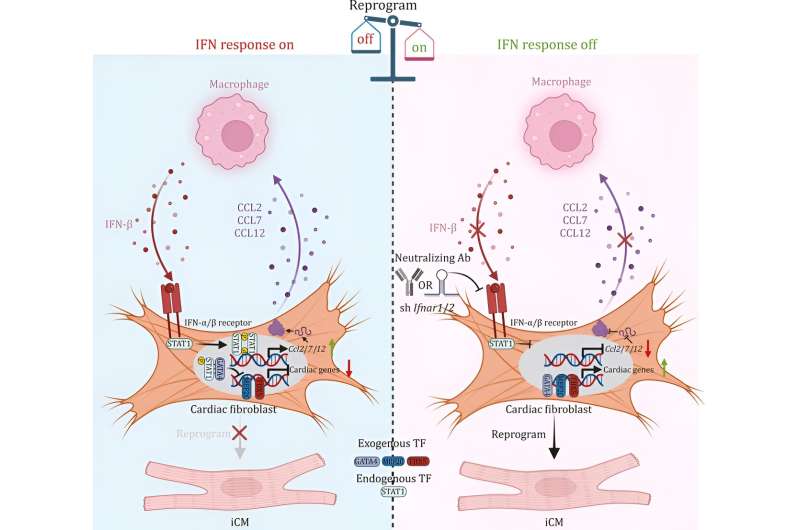This article has been reviewed according to Science X's editorial process and policies. Editors have highlighted the following attributes while ensuring the content's credibility:
fact-checked
proofread
The molecular mechanisms underlying cardiac repair

A paper, "Macrophages suppress cardiac reprogramming of fibroblasts in vivo via IFN-mediated intercellular self-stimulating circuit," published in Protein & Cell uncovers a previously unappreciated mechanism by which macrophages influence the fate of CFs post-MI.
It demonstrates that macrophage-derived IFN-β stimulates the IFN-β-IFNAR-p-STAT1 axis in CFs, leading to the upregulation of chemokines (CCL2/7/12) that attract more macrophages.
This process forms a positive feedback loop that impedes cardiac reprogramming. The study also shows that inhibiting the IFN signaling pathway or depleting macrophages can downregulate STAT1 activation and improve reprogramming efficiency, promoting cardiac regeneration.
Key findings from the study include:
- Role of IFN-β in cardiac reprogramming: Macrophage-secreted IFN-β inhibits the reprogramming of CFs to CMs in vivo by activating the IFN-β-IFNAR-p-STAT1 pathway, which interferes with GATA4's function in cardiac gene transcription.
- Positive feedback loop: Activated CFs secrete CCL2/7/12 chemokines that recruit additional macrophages, which in turn secrete more IFN-β, enhancing STAT1 phosphorylation and creating a self-reinforcing loop that suppresses reprogramming.
- Inhibition of IFN signaling enhances reprogramming: Blocking the IFN signaling pathway or depleting macrophages reduces STAT1 activation and facilitates cardiac reprogramming, indicating potential therapeutic targets for cardiac regeneration.
This study elucidates the complex interplay between macrophages and CFs in the MI microenvironment, highlighting the role of the IFN-β-IFNAR-p-STAT1 signaling pathway as a critical barrier to cardiac reprogramming.
By demonstrating that disruption of this pathway improves reprogramming efficiency and cardiac function in vivo, the research opens new avenues for developing strategies to enhance cardiac regeneration.
The findings contribute to understanding the molecular mechanisms underlying cardiac repair and suggest that targeting the IFN signaling pathway could be a promising therapeutic approach for myocardial infarction.
More information: Hao Wang et al, Macrophages suppress cardiac reprogramming of fibroblasts in vivo via IFN-mediated intercellular self-stimulating circuit, Protein & Cell (2024). DOI: 10.1093/procel/pwae013





















